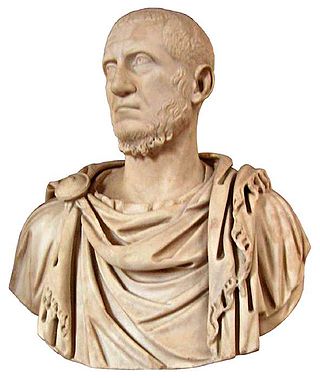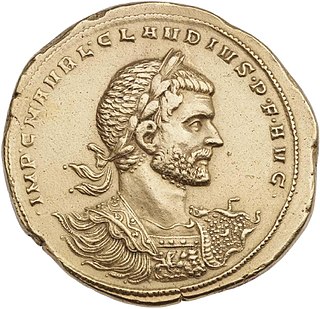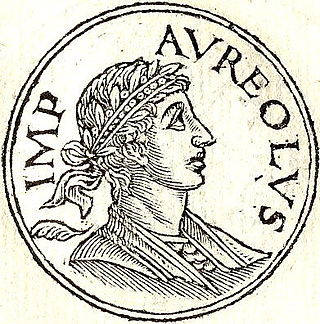
Publius Licinius Egnatius Gallienus was Roman emperor with his father Valerian from 253 to 260 and alone from 260 to 268. He ruled during the Crisis of the Third Century that nearly caused the collapse of the empire. He won numerous military victories against usurpers and Germanic tribes, but was unable to prevent the secession of important provinces. His 15-year reign was the longest in half a century.
The 160s decade ran from January 1, 160, to December 31, 169.
The 270s decade ran from January 1, 270, to December 31, 279.

Year 271 (CCLXXI) was a common year starting on Sunday of the Julian calendar. At the time, it was known as the Year of the Consulship of Aurelianus and Bassus. The denomination 271 for this year has been used since the early medieval period, when the Anno Domini calendar era became the prevalent method in Europe for naming years.
The 250s was a decade that ran from January 1, 250, to December 31, 259.
The 260s decade ran from January 1, 260, to December 31, 269.

Year 274 (CCLXXIV) was a common year starting on Thursday of the Julian calendar. At the time, it was known as the Year of the Consulship of Aurelianus and Capitolinus. The denomination 274 for this year has been used since the early medieval period, when the Anno Domini calendar era became the prevalent method in Europe for naming years.

Year 275 (CCLXXV) was a common year starting on Friday of the Julian calendar. At the time, it was known as the Year of the Consulship of Aurelianus and Marcellinus. The denomination 275 for this year has been used since the early medieval period, when the Anno Domini calendar era became the prevalent method in Europe for naming years.
Year 259 (CCLIX) was a common year starting on Saturday of the Julian calendar. At the time, it was known as the Year of the Consulship of Aemilianus and Bassus. The denomination 259 for this year has been used since the early medieval period, when the Anno Domini calendar era became the prevalent method in Europe for naming years.
Year 270 (CCLXX) was a common year starting on Saturday of the Julian calendar. At the time, it was known as the Year of the Consulship of Antiochianus and Orfitus. The denomination 270 for this year has been used since the early medieval period, when the Anno Domini calendar era became the prevalent method in Europe for naming years.

Year 260 (CCLX) was a leap year starting on Sunday of the Julian calendar. At the time, it was known as the Year of the Consulship of Saecularis and Donatus. The denomination 260 for this year has been used since the early medieval period, when the Anno Domini calendar era became the prevalent method in Europe for naming years.

Year 268 (CCLXVIII) was a leap year starting on Wednesday of the Julian calendar. At the time, it was known in Rome as the Year of the Consulship of Paternus and Egnatius. The denomination 268 for this year has been used since the early medieval period when the Anno Domini calendar era became the prevalent method in Europe for naming years.

Marcus Aurelius Claudius "Gothicus", also known as Claudius II, was Roman emperor from 268 to 270. During his reign he fought successfully against the Alemanni and decisively defeated the Goths at the Battle of Naissus. He died after succumbing to a "pestilence", possibly the Plague of Cyprian that had ravaged the provinces of the Empire.

The Gallic Empire or the Gallic Roman Empire are names used in modern historiography for a breakaway part of the Roman Empire that functioned de facto as a separate state from 260 to 274. It originated during the Crisis of the Third Century, when a series of Roman military leaders and aristocrats declared themselves emperors and took control of Gaul and adjacent provinces without attempting to conquer Italy or otherwise seize the central Roman administrative apparatus.

Marcus Cassianius Latinius Postumus was a Roman commander of Batavian origin, who ruled as emperor of the splinter state of the Roman Empire known to modern historians as the Gallic Empire. The Roman army in Gaul threw off its allegiance to emperor Gallienus around the year 260, and Postumus assumed the title and powers of Emperor in the provinces of Gaul, Germania, Britannia, and Hispania. He ruled for the better part of ten years before he was murdered by his own troops.

Marcus Piavonius Victorinus was emperor in the Gallic provinces from 268 to 270 or 269 to 271, following the brief reign of Marius. He was murdered by a jealous husband whose wife he had tried to seduce.

Gaius Pius Esuvius Tetricus was a Gallo-Roman nobleman who ruled as emperor of the Gallic Empire from 271 to 274 AD. He was originally the praeses of Gallia Aquitania and became emperor after the murder of Emperor Victorinus in 271, with the support of Victorinus's mother, Victoria. During his reign, he faced external pressure from Germanic raiders, who pillaged the eastern and northern parts of his empire, and the Roman Empire, from which the Gallic Empire had seceded. He also faced increasing internal pressure, which led him to declare his son, Tetricus II, caesar in 273 and possibly co-emperor in 274, although this is debated. The Roman emperor Aurelian invaded in 273 or 274, leading to the Battle of Châlons, at which Tetricus surrendered. Whether this capitulation was the result of a secret agreement between Tetricus and Aurelian or that surrender was necessary after his defeat is debated. Aurelian spared Tetricus, and made him a senator and the corrector (governor) of Lucania et Bruttium. Tetricus died of natural causes a few years after 274.

Aureolus was a Roman military commander during the reign of Emperor Gallienus before he attempted to usurp the Roman Empire. After turning against Gallienus, Aureolus was killed during the political turmoil that surrounded the Emperor's assassination in a conspiracy orchestrated by his senior officers. Aureolus is known as one of the Thirty Tyrants and is referenced in ancient sources including the Historia Augusta, Zonaras' epitome and Zosimus' Historia Nova.
Marcus(?) Aurelius Heraclianus was a Roman soldier who rose to the rank of Praetorian Prefect in the latter part of the reign of the Emperor Gallienus. He was a member of the cabal of senior commanders of the Imperial field army that plotted and achieved the assassination of the Emperor Gallienus. His subsequent fate is uncertain. The only ancient reference has him committing suicide, but the circumstances are unclear.
Postumus was a Roman usurper and founder of the Gallic Empire.












